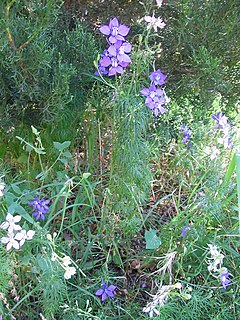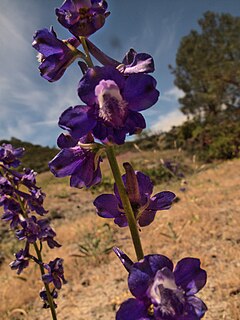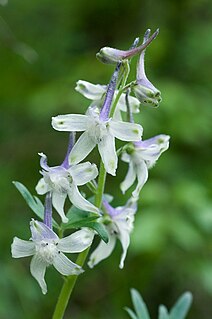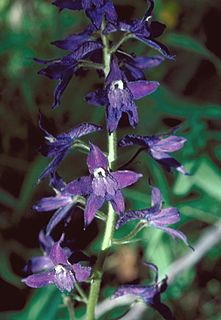
Delphinium is a genus of about 300 species of perennial flowering plants in the family Ranunculaceae, native throughout the Northern Hemisphere and also on the high mountains of tropical Africa. The genus was erected by Carl Linnaeus.

Consolida ajacis is an annual flowering plant of the family Ranunculaceae native to Eurasia. It is widespread in other areas, including much of North America, where it is an introduced species. It is frequently grown in gardens as an ornamental for its spikes of blue, pink or white flowers. It may reach a meter in height. Since the aerial parts and seeds of C. ajacis have been found to contain diterpenoid alkaloids, including the highly toxic methyllycaconitine, the plants should be considered as poisonous.

Methyllycaconitine (MLA) is a diterpenoid alkaloid found in many species of Delphinium (larkspurs). In common with many other diterpenoid alkaloids, it is toxic to animals, although the acute toxicity varies with species. Early research was focused on identifying, and characterizing the properties of methyllycaconitine as one of the principal toxins in larkspurs responsible for livestock poisoning in the mountain rangelands of North America. Methyllycaconitine has been explored as a possible therapeutic agent for the treatment of spastic paralyses in man, and it has been shown to have insecticidal properties. Most recently, it has become an important molecular probe for studying the pharmacology of the nicotinic acetylcholine receptor.

Delphinium nudicaule, known by the common names canyon larkspur, red larkspur, orange larkspur, and canyon delphinium, is a flowering herbaceous perennial plant in the buttercup family Ranunculaceae. It is native to low-elevation canyons and slopes, foothills, and mountain ranges of California, US, from the Sierra Nevada to the California Coast Ranges, and of Oregon. It grows below 6,500 feet (2,000 m).

Delphinium patens is a species of larkspur known by the common names zigzag larkspur and spreading larkspur. It is a wildflower limited mainly to California. Though not yet confirmed there, it is expected in Baja California. Plants grow typically 20 to 50 centimeters tall and bear up to 36 flowers each. The stems are mostly hairless, have reddish bases, and bears leaves on the lower half. Each leaf is divided into 3 to 9 lobes. The flower has dark blue sepals, the latter ones reflexed. The spur at the back of the flower is 4 to 8 millimeters long. The cleft at the center of the flower has white or yellowish scattered hairs. The elongated fruit is one or two centimeters long and contains pitted seeds.

Delphinium andersonii is a species of perennial larkspur known as Anderson's larkspur. This wildflower is native to western North America, where it can be found in the Great Basin and the Sierra Nevada.

Delphinium californicum is a species of larkspur known as California larkspur. This wildflower is endemic to California, where it is a resident of the chaparral slopes of the San Francisco Bay Area and Central Coast.
Delphinium decorum is a species of larkspur known by the common names coastal larkspur and yellowtinge larkspur. This wildflower is endemic to California, where it grows on the slopes of the coastal ranges in the San Francisco Bay Area and north. It grows an erect stem which approaches half a meter in height at maximum. The leaves, which are divided into a number of narrow lobes, are mostly located about the base of the plant. The spindly stem above bears two to twenty widely spaced flowers. Each flower is carried on a pedicel several centimeters long. The five long, flat sepals are extended to give the face of the flower a star shape, and they are usually deep blue to purple. The petals are similar in color, except the top two may be lighter to almost white. The spur is very thin and may be nearly two centimeters long.

Delphinium depauperatum is a species of larkspur known by the common names slim larkspur and dwarf larkspur. This wildflower is native to western North America where it is found in mountain meadows. It grows from a short root and erects a stem usually under 40 centimeters in maximum height. The small leaves are divided into lobes and are usually located about the base of the plant. Toward the top of the stem are flowers on long pedicels, with usually not more than 20 flowers per plant. The flowers generally have deep dark blue sepals which are flat and extended to the sides, and petals which are mainly the same color except for the top two, which may be lighter blue to white. The spur is between one and two centimeters long.

Delphinium glaucum, known by the common names Sierra larkspur, mountain larkspur, and glaucous larkspur, is a species of wildflower in the genus Delphinium, which belongs to the buttercup family, Ranunculaceae. It is native to western North America from Arizona to Alaska, growing in moist mountainous environments such as riverbanks and meadows.
Delphinium gracilentum is a species of larkspur known by the common name pine forest larkspur. It is endemic to California, where it grows throughout the Sierra Nevada. This wildflower is usually around half a meter in maximum height, with leaves growing from the lowest third of the stem. The leaves usually have five lobes. The upper part of the stem is occupied by widely spaced flowers, which each grow at the end of a pedicel a few centimeters long. The flower color may be any shade of blue, or occasionally white or pinkish. The sepals often curl backwards. The spur is usually between 1 and 1.5 centimeters long.

Delphinium gypsophilum is a species of larkspur known by the common name Pinoche Creek larkspur. It is endemic to California, where it grows throughout the central part of the state in woodland and grassland. This wildflower generally reaches between one half and one meter in height. Its pale whitish-green stem is topped with cylindrical inflorescences of up to 30 flowers on short pedicels. The flowers are chalk-white, sometimes drying to a faint blue. Occasional individuals bear pink or light blue flowers. The spur is one to one and a half centimeters long.
Delphinium hansenii is a species of larkspur known by the common names Eldorado larkspur and Hansen's delphinium. It is endemic to California, where it grows in mountains, valleys, and desert from the southern Cascade Range to the Mojave Desert. This wildflower usually grows between one half and one meter in height, although it can grow much taller. The deeply lobed leaves are hairy, especially on the undersides. The inflorescence has usually over 25 flowers grouped close together at the top of the stem and held on long pedicels. The flowers are white to light blue or light pink, or bicolored, and vary in size. The inner petals may be quite hairy.

Delphinium parryi is a species of larkspur known by the common names San Bernardino larkspur and Parry's larkspur. This wildflower is native to Baja California and California from the San Francisco Bay Area south. It is found in chaparral and woodlands and other habitats.

Delphinium trolliifolium is a species of larkspur known by the common names poison delphinium, cow poison, and Columbian larkspur. It is native to Washington, Oregon, and northern California. This wildflower reaches one half to just over one meter in height. It has large, shiny, deeply lobed leaves. The top half of the stem is an inflorescence of widely spaced flowers on long pedicels, the longest over nine centimeters long. The flowers are usually deep brilliant blue. The upper two petals may be milky white. The spur exceeds two centimeters in length in the largest of the flowers. This plant is toxic as suggested by the common names, but most larkspur species are toxic to some degree.

Delphinium bicolour is a species of larkspur known as little larkspur and low larkspur. It is native to northwestern North America from British Columbia to South Dakota, where it grows in mountain forests and foothill scrub and prairie. This is a perennial herb growing from a thickly branching root system. It produces solitary stems to 40 centimetres (16 in) in height and green with reddish bases. Most of the leaves are low on the stem and grow on short petioles. They are several centimeters long with many rounded lobes. The small inflorescence holds a few large flowers per stem. The flower has dark purple-blue sepals each about 2 centimeters long and a spur of 1 to 2 centimeters. The plant is poisonous to cattle, less so to sheep, and it is occasionally eaten by various species of wild cervids.

Delphinine is a toxic diterpenoid alkaloid found in plants from the Delphinium (larkspur) and Atragene genera, both in the family Ranunculaceae. Delphinine is the principal alkaloid found in Delphinium staphisagria seeds – at one time, under the name stavesacre, a very well known herbal treatment for body lice. It is related in structure and has similar effects to aconitine, acting as an allosteric modulator of voltage gated sodium channels, and producing low blood pressure, slowed heart rate and abnormal heart rhythms. These effects make it highly poisonous. While it has been used in some alternative medicines, most of the medical community does not recommend using it due to its extreme toxicity.

Delphinium uliginosum is a species of larkspur known by the common names swamp larkspur and bog larkspur. It is endemic to California, where it is known from very localized populations in the Inner North Coast Ranges. It grows in chaparral, grassland, and other habitat in the hills, generally on serpentine soils. This is a perennial herb producing a hairless, erect stem up to 70 centimeters tall. It can be identified by its leaves, which are fan-shaped, a characteristic unique among the larkspurs, which generally have palmate leaves with narrow, fingerlike lobes. The inflorescence bears up to 45 flowers, each on an upright pedicel which may exceed 10 centimeters long. The flower is blue with the longest sepals 1.4 centimeters long and a spur about the same length. The fruit is one or two centimeters long.

Delphinium tricorne, known by the common name dwarf larkspur, is a species of flowering plant in the buttercup family. It is native to the eastern United States, where it is the most common Delphinium found. It is found in rich mesic forests, often over calcareous rocks.

Delphinium barbeyi is a species of flowering plant in the buttercup family known by the common names subalpine larkspur, tall larkspur, and Barbey's larkspur. It is native to the interior western United States, where it occurs in the states of Arizona, Colorado, New Mexico, Utah, and Wyoming.

















